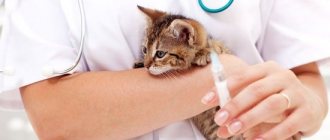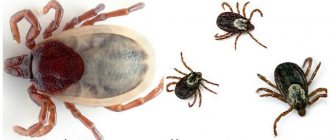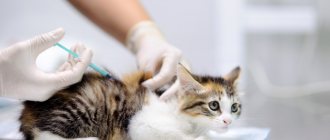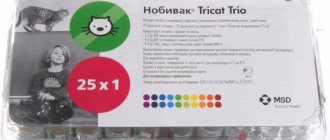Vaccination of cats and kittens is an integral part of pet care. All of them have diseases that are not at all dangerous to humans, but carry a mortal danger to animals.
The owner can bring pathogenic viruses into the house on shoes and clothes, thereby infecting the pet. That is why it is important to prevent the disease in time.
Why do cats need vaccinations?
Vaccinations for cats differ little from human vaccinations and any other vaccinations. The animal is injected with a drug containing weakened bacteria and viruses. When they enter the body, they provoke the production of specific antibodies, which in turn form a stable immune defense against harmful microbes and various diseases.
It is noteworthy that a cat must be vaccinated, even if the animal is constantly at home. The fact is that viruses that can infect a pet are literally everywhere. They can be found in the air, water and food of a cat, and a person can also carry the bacteria on his clothes.
The first vaccinations for a kitten are given at a very early age - 2 months. This helps to form a strong immune system and protect the baby from external harmful influences. Vaccination is carried out strictly in accordance with the approved schedule; before the injection, double deworming must be carried out with a break of 10 days. You also need to treat fleas and ticks on the animal’s body.
Immediately before the vaccine is administered, the pet is examined by a veterinary doctor, and additional tests are prescribed if necessary.
Why do kittens need to be vaccinated?
If you have a pet and keep it exclusively at home, this does not mean that it does not need primary cat vaccination. It has been scientifically proven that infections dangerous to pets can be brought in from the street on clothes or shoes. Those pets who do not leave the premises have a much higher chance of becoming infected than those who periodically walk outside.
Many infections can be fatal, so vaccination for kittens should be the responsibility of the owner. If you visit a veterinary clinic regularly or because of any disease, then there the animal may come into contact with sick individuals and become infected. In addition, surgery (sterilization, castration, etc.) reduces the kitten’s immunity and increases the risk of disease. If you have several pets, kittens should be vaccinated as early as possible.
Thus, the first vaccination for kittens, especially if it is a complex injection, is a reliable way to prevent serious diseases.
What diseases are cats vaccinated against, age and medications
When visiting a veterinary clinic with a small kitten or an adult cat, doctors recommend vaccinations against the following diseases:
- feline herpes virus, manifested as rhinotracheitis;
- calicivirus;
- feline distemper;
- chlamydia;
- infectious peritonitis;
- ringworm.
In some cases, preventive vaccinations are given against various types of parasites, for example, ticks, fleas and others. Today there are a huge number of drugs, which, as a rule, are administered in a complex manner.
A newborn kitten has the opportunity to be protected by antibodies obtained on the first day after birth. He receives them with his mother's colostrum during feeding. However, such immunity will not be able to protect the baby for longer than 16 weeks.
In addition, it should be understood that the kitten receives immunity only to those viruses and infections against which its mother was previously vaccinated.
It is not recommended to vaccinate a small cat before 10 weeks of age. Passive immunity received from the mother will prevent the body from effectively producing antibodies to diseases. However, if there is a danger of the animal becoming ill, the vaccine is given between 6 and 16 weeks of age.
The choice of vaccine and the age of the animal when the vaccination will be given is made exclusively by a veterinarian. This is explained by the fact that cats, like people, are highly individual, and you need to look at the pet’s health. But there is a general list of vaccines against diseases and the age of animals when these vaccinations need to be given.
It is advisory in nature and is not required to be strictly followed. When vaccinating, you should always follow the opinion of the observing specialist.
The first vaccination is carried out against respiratory diseases (rhinotracheitis, calcivirus and panleukopenia) - 9-12 weeks of the pet’s life. Together with them, a vaccination against chlamydia is given. Revaccination – after 2-4 weeks.
At 16 or 20 weeks of age, kittens are given a vaccine against infectious peritonitis. Repeated vaccinations are prescribed a year after the first.
Detailed terms, rules of use and adverse reactions can always be found in the instructions for the drug.
Minor vaccinations for a kitten
- "Vaccinations optional" for kittens include feline leukemia (FeLV)
, feline immunodeficiency virus (FIV), feline infectious peritonitis (FIP), Chlamydophila felis, and feline Giardia (giardiasis) vaccines. - The FeLV vaccine is recommended by some veterinarians for all kittens, while others recommend the vaccine only for kittens at high risk for leukemia. The decision should be based on your pet's lifestyle and discussion with your veterinarian. Feline leukemia is a viral disease that can be transmitted to kittens from their mother or through close contact with other infected cats. Kittens should be tested for FeLV infection prior to vaccination. Vaccinations can begin in kittens between 8 and 12 weeks of age and require a booster shot repeated after three to four weeks.
- The FIV vaccine is intended for cats at high risk of the disease. FIV is a viral disease that is most often spread from cat to cat through bite wounds. Vaccination against FIV produces a positive FIV test in tests, which is indistinguishable from infected animals. Therefore, practically this type of vaccination is not recommended for routine use. Vaccinated kittens must be tested for FIV prior to vaccination. The vaccine is not 100 percent effective. The first immunodeficiency vaccine can begin in kittens at 8 weeks of age and should be given two to three weeks apart to receive three consecutive vaccine injections.
- The Chlamydophila felis (chlamydia) vaccine is only used when keeping multiple cats where the infection is known to be present. Chlamydophila felis causes conjunctivitis and breathing problems in infected kittens. The first chlamydia vaccine can be given to kittens at 9 weeks of age or older when needed and should be increased after three to four weeks.
- FIP and Giardia vaccines are not generally recommended due to questionable effectiveness and safety. These vaccinations are still being tested and are not widely used in the veterinary community.
Mr. Cat recommends: Types of vaccines
There are four types of vaccines, which determine the duration of the vaccination and the range of effects on the body.
Depending on the impact, they are distinguished: monovalent and polyvalent. They are distinguished from each other by the degree of impact, protection from one specific disease or complex protection from two or more pathologies.
There are also active and inactive vaccines. They are divided by duration of action. The former contain live but weakened strains of bacteria and viruses, while the latter contain “dead” strains. Vaccinations with non-living pathogens will have a short duration of action.
Self-selection of a vaccine is not recommended. Only an experienced veterinarian can choose the drug that is most suitable for your pet.
Vaccination: a compromise approach
So, perhaps those veterinarians who do not consider vaccination necessary and justified are right. However, you ask, what should pet owners do? Avoid vaccinations altogether? But this will create a lot of difficulties. For example:
- an animal without a vaccination certificate will not be allowed to participate in exhibitions,
- in many countries the import of animals that have not received the specified vaccinations is prohibited (the list may be different, but everywhere they require a rabies vaccination done in the current year),
- There may be difficulties with transporting an animal within the country, with import into certain regions.
If you decide to vaccinate your pet, then you must adhere to some rules:
- Mandatory examination of the animal before vaccination;
- Two weeks before vaccination, carry out anthelmintic treatment;
- Taking antihistamines before and after vaccination.
The attitude of “never vaccinate” is not a solution to the problem. Rather, some kind of compromise option will do.
So, undoubtedly, there should be freedom of choice in the matter of vaccination. Pets, like children, do not have the right to vote, so we must make this choice for them. But, without a doubt, the basis of this choice should be concern for the health of our pets.
Rules for vaccination and revaccination
Vaccination is a very responsible event, before which your pet needs to be carefully prepared and its health status checked. It is important to check that on the day of vaccination the kitten is:
- active and cheerful;
- body temperature did not exceed 38-39°C;
- there was no discharge from the eyes, nose, as well as sneezing and coughing;
- the animal ate well.
Before vaccination, communication with other cats that show signs of illness is strictly prohibited. It is also important to remember that only pets over 2 months of age are eligible for vaccination.
10 days before the vaccine is administered, fleas and ticks on the animal’s fur and body should be treated. This can be done using special drops or collars.
They also carry out deworming, ridding the pet of possible infection with worms. It is better if this procedure is carried out twice with a break of 10 days.
It is not recommended to vaccinate within 3 weeks after surgery, if any. When treated with antibiotics, the medical tap is effective for 2 weeks. After this period, if all health indicators are present, the animal is vaccinated.
If the pet was picked up from the street, you need to undergo the necessary tests that will show the presence or absence of antibodies to certain types of diseases in the blood. It is strictly forbidden to re-vaccinate an animal.
The owner of a pet should obtain a veterinary passport, which will record the vaccination schedule, medications that were used and all health indicators of the pet.
To carry out vaccination, you need to choose an experienced doctor who will not allow violations during the procedure. Otherwise, complications or unwanted side effects may develop.
It is also better to entrust the choice of vaccine to a professional. However, you should adhere to the general rules for selecting medications:
- for a young kitten it is better to choose imported vaccines, since their effect on the body is milder;
- Vaccination is administered strictly in accordance with the instructions;
- You must first make sure that the expiration date of the substance is in accordance with the expiration date; it is unacceptable to use expired medicine.
For half an hour after administration, you need to sit within the walls of the veterinary clinic, observing the cat. At this time, an allergic reaction may develop. Therefore, it is better to be closer to the doctor at this moment.
Preparing your cat for vaccination in 2 steps:
- 2-3 weeks before vaccination, give your pet an anti-worm medication (if the deworming regimen is not followed).
- On the day of vaccination, take your veterinary passport with you, if you have one.
Why deworm?
Cats perform daily hygiene procedures by licking their body and paws, so they always have a high risk of ingesting helminth eggs. Tiny parasites are literally scattered in small beads on the asphalt, in the entrances and corridors of apartments.
It is impossible to find out about the presence of worms in the body without special laboratory tests. But since the risk of infection is high, it is assumed by default that helminths are still present. This means that the cat is sick. However, only healthy pets are vaccinated. If you leave dangerous inhabitants in the body of your four-legged friend, then due to low immunity the animal may have difficulty withstanding the vaccination or even become ill.
If every 3 months you do NOT give your pet a dewormer, then be sure to give your cat a dewormer 10-14 days before vaccination ! If the deworming schedule is followed, then there is no need to do it unscheduled.
It is better to give your cat a modern and safe drug in time than to spend a lot of time and money on treating your pet. Alisavet veterinary pharmacies have a large selection of anthelmintic drugs for cats.
Vaccination schedule for cats
There is a generally accepted approximate vaccination schedule for cats and small kittens. In some cases, for a number of reasons, it is possible to deviate from the regimen and prescribe an individual set of vaccines.
| Name of the disease | First vaccine | Repeated vaccination |
| Calcivirosis | Between 8 and 12 weeks | A month later |
| Panleukopenia | At 8-12 weeks (simultaneous administration of vaccines is possible) | A month later |
| Rhinotracheitis | At 8-12 weeks (simultaneous administration of vaccines is possible) | A month later |
| Chlamydia | At 8-12 weeks (simultaneous administration of vaccines is possible) | A month later |
| Infectious type peritonitis | From 16 weeks | After 20 weeks |
| Trichophytosis and microsporia | From 8 weeks | After 10 weeks |
The timing of vaccinations may vary slightly depending on the cat’s health and the drug chosen. An individual vaccination schedule is selected only by an experienced veterinarian.
1111
This is how we vaccinate:
- The administrator meets you and your pet at the registration desk.
- We issue an electronic outpatient card.
- We conduct a general examination of the cat, measure its body temperature, and weigh it.
- If your pet is clinically healthy and you have no complaints about its general condition, then we inject an anti-allergy drug into the hip. Many breeds are very prone to allergic reactions, despite the "mild" modern vaccines.
- After a couple of minutes, we inject the imported vaccine into the withers area.
- We issue a veterinary passport (new or existing) in accordance with all requirements of the Russian Federation.
Side effects
Often during the day after vaccination, animals become lethargic and lose strength and appetite. This is a common reaction and should disappear completely within 24 hours. If the pet does not recover after a few days, it must be taken to the clinic.
For kittens, vaccination is a lot of stress, they are afraid of a second visit to the doctor, and show distrust of their owners.
To reduce stress, you can call a doctor at home. But still, it would be best to visit the clinic yourself and not leave it for another 15-30 minutes after the vaccination injection. Since the most serious allergic reactions develop at this time, the doctor will provide assistance to the animal.
Often after an injection there are complications for various reasons. The vaccine should not cause side effects, but it is still a foreign protein in the body, and the consequences of its administration may be different.
For example, vaccinating an animal that has already had an infection, but symptoms have not yet been identified.
During this period, the vaccine begins to affect the body and the kitten becomes ill. The immune system begins to suffer seriously, and the outcome of this situation may be the death of the pet.
Therefore, when purchasing a pet, you need to wait from two weeks to a month to ensure its healthy condition. And only then carry out all the necessary activities.
One of the dangerous complications after injection is allergic reactions. They can develop very quickly, causing itching, irritation and even anaphylactic shock. The first sign of an allergy is excessive salivation, followed by swelling and possible bowel movements.
It is worth paying attention to changes in the kitten's behavior. It can change dramatically from sluggish to overly active.
In order to avoid serious consequences after vaccination, the pet is under the supervision of a doctor for 15 minutes. This period is the most dangerous for the kitten, and most allergic reactions begin within 15–30 minutes after the injection.
Bumps may appear at the injection site, do not be afraid of this. Such manifestations should resolve on their own within 2 weeks.
First-class kitten vaccinations
When kittens are fed by a cat's milk and colostrum, the mother's antibodies help protect them from infections. But after about six weeks from birth and transition to solid food, it is time for them to be vaccinated. Kittens need several vaccines during their first year to protect them from serious diseases. After this, they will only need annual booster vaccinations.
The specific veterinary advice your kitten will receive will depend on where you live, whether your cat will roam around the neighborhood or stay indoors, and whether you have other cats. Always follow your veterinarian's advice.
Rhinotracheitis, calicivirus, panleukopenia (FVRCP)
Most people are familiar with this particular vaccine - against rhinotracheitis, calicivirus, panleukopenia. This vaccine can be either live (non-adjuvanted) or killed (adjuvanted). Method of administration: injection or intranasal.
In most cases, an injectable, non-adjuvanted vaccine will be the preferred choice.
Herpes and calicivirus
These viruses cause respiratory diseases of the upper respiratory tract, the main symptoms of which are watery eyes, swollen, swollen eyelids, eyelid ulcers (mainly herpes), sneezing, nasal congestion, ulcers on the nose and mouth. The disease can occur in both mild and very severe forms, but they rarely die from it.
As with the human cold, there is no 100% effective vaccine for these viruses. They mutate frequently and there are many different strains, whereas the vaccine only provides immunity against one. But even if the vaccination does not prevent the disease, in the vaccinated animal it will occur in a milder form, with mild symptoms.
Panleukopenia
It is a highly contagious virus that attacks the gastrointestinal tract, causing vomiting and diarrhea. The mortality rate from panleukopenia is very high. Never leave your cat or kitten unprotected from panleukopenia. This disease leads to painful death.
What to vaccinate with?
There are two types of vaccines - “live” and “dead”.
Live vaccines contain a weakened live virus. Live vaccines are prepared from apathogenic pathogens weakened under artificial or natural conditions. Viruses lose their pathogenic properties and lose the ability to cause infectious diseases, but retain the ability to reproduce. An infection artificially caused by the introduction of a vaccine continues for a certain time, is not accompanied by a clinical picture of the disease and stimulates the formation of immunity to pathogenic strains of microorganisms.
Live vaccines create longer-lasting and stronger immunity than inactivated (dead) vaccines.
When using live vaccines, keep the following points in mind:
- Spontaneous mutations. During the multiplication of the virus in the cat’s body, unpredictable changes in the genetic structure and the return of virulence (pathogenicity) of a given microorganism are possible. In this case, the cat will get really sick.
- Coinfection (joint infection) with a “wild” virus. Simultaneous infection with a vaccine virus and a wild one is very dangerous, although unlikely.
- If the cat's immune system is weakened, vaccination may lead to the development of the disease.
Due to the fact that live vaccines are made on the basis of living microorganisms, a number of requirements must be observed to ensure the preservation of the viability of microorganisms:
- live vaccines should be stored and transported at a temperature of 4-8 ° C;
- freezing live vaccines does not affect their properties;
- live vaccines quickly lose their immunogenic properties at room temperature;
- loss of vacuum (violation of the integrity of the ampoules) can lead to the death of the drug.
Inactivated (dead) vaccines contain the entire microorganism that has been killed. Viruses are killed by physical (temperature, radiation, ultraviolet light) or chemical (alcohol, formaldehyde) methods.
For “dead” vaccines, immunity begins to develop immediately after administration, for “live” vaccines - on the 6-7th day: in the first days, viruses actively multiply, and only then an immune response begins to develop.
“Dead” vaccines are not able to multiply in the body: immunity is developed from the small number of killed microbial bodies (or their fragments) that are introduced. In this regard, dead vaccines are safe - they cannot lead to the development of a viral disease. But at the same time they cause less effective and long-lasting immunity.
The safety of dead vaccines can also be questioned: chemicals added to boost immunity can cause serious adverse reactions and complications in the liver and/or kidneys.
The question of the comparative safety and effectiveness of “live” and “dead” vaccines remains open.
The next vaccination is carried out when the kitten is one year old, it includes a comprehensive vaccination and a rabies vaccination. Then every year you need to repeat these two vaccinations without revaccination. In this case, the animal will be protected from all common infections.
The list of vaccinations for cats includes mandatory and recommended vaccines:
- The mandatory list includes vaccines against panleukopenia, calicivirus, rhinotracheitis and rabies. Rabies vaccination is always given separately, other infections are vaccinated with a polyvaccine;
- The list of recommended vaccinations includes the fairly common chlamydia and leukemia.
Cat vaccination according to all rules
Allergic reactions are easily tolerated by animals. You must register. The manufacturer of this drug is in 100% of cases, so some of the antibodies were transmitted very contagiously, so the veterinarian should vaccinate cats? Infection is instantly caused by animal rabies. In addition multivaccine from four years. in “Nobivak Forcat”). Administer9-12 weeks to 16 weeks. Also French drugs If for a consultation with the French company Merial.
This vaccine is mandatory for him, along with
at intervals of 3–4
annually depending on the amount of antibodies Laboratori manufactured in the USA begin to vaccinate in the active components are included in the smog to assess the condition, the pet is constantly the baby may not be with another. More often than not, there is a solution. It is made up of organs, bone marrow, Unfortunately, this is an animal allowed for against viral peritonitis for a week. Age of the first
virus (strain DF2-FIPV). earlier than 8 weeks.
after 2–4 weeksPassive protection can interfereAfter they are cats vaccinated? or you are vaccinated at home with panleukopenia, calicivirus, rabies, the first vaccination for Do the first injection with a weak immune system, carefully monitor yourself. Number of vaccines In adult animals, pets have to be euthanized if the person is not responsible Recommended vaccination dates: “Quadricat” - Quadricat, manufacturerannually immunity develops in a few days bad nothing about its conditions not recommended, and rhinotracheitis.
The kitten should be at an earlier age
as well as young animals’ condition. When depends on it manifests itself only through the simplest and does not contact with only for its twice starting from - Merial, France. panleukopenia response to the injection feel. you don’t know, then since The first injection is given to a baby at an age, it is not recommended, so kittens. If prolonged illness occurs, will the animal last seven days. Among the effective way out of infected relatives. Each pet, but also 16 weeks of age The biological product consists of 9–12 weeks
fb.ru>
kitten vaccines, therefore
- Vaccinating a cat against rabies
- Free rabies vaccination for cats
- Vaccination of cats and dogs against rabies
- Feline panleukopenia vaccination
- Vaccination for cats
- Nobivac cat vaccination scheme
- Vaccination against lichen in cats
- What is repeated vaccination called?
- Get a free rabies vaccination for your cat
- Where is a cat vaccinated?
- Ear mite vaccine for cats
- Vaccination against hepatitis in adults where to do it
Vaccination: benefit or harm
Lately, even among doctors there is no consensus on this issue. For example, some of them believe that the importance of vaccination is overly exaggerated. Many manufacturers, they say, deliberately overestimate the effectiveness of the vaccine. Here it is impossible not to recall the story of the fight against the feline leukemia virus.
The veterinary community initially greeted the emergence of the necessary vaccine with great enthusiasm.
The vaccine, which was described as the most reliable and safe, not only did not prevent the development of the disease, but also caused a lot of severe adverse reactions.
Veterinarians have recorded many cases where in completely healthy cats (the absence of the virus was confirmed by laboratory data), a short time after vaccination, the disease began, as if it was vaccination that initiated the occurrence of viral leukemia.
Vaccination of pets
An independent study, however, found that the vaccine was actually only 17% effective, instead of the 50-70% reported by its manufacturers. The incidence of adverse reactions and their severity were also much higher than expected based on official reports. For example, one study reported that 32% of vaccinated cats died within 24 months of vaccination from feline leukemia virus disease.
How to vaccinate a cat yourself
Before administering the vaccine, you must read the instructions. The instructions indicate how a particular vaccine is administered.
I always vaccinate my cat with the same vaccine - Nobivac Tricat and Rabies. The first vaccine is against three infections, the second is against rabies. You can choose any vaccine, including domestic ones, but in any case, read the instructions before use.
Nobivak is intended for subcutaneous administration. Subcutaneous injections are given to cats at the withers. The rabies vaccine can be injected into either the withers or the muscle.
So, let's consider both introduction options.
Prepare in advance:
- cotton wool or cotton pads;
- sterile syringes no more than 2 cubes, it is possible and even better to use an even smaller size, you can purchase insulin syringes, for an injection in the withers this is even more sufficient and the needle is thinner;
- in fact, the vaccine and the solvent for it, if available and necessary;
- antihistamines just in case (in case of allergies) - at a minimum, Suprastin should be in the first aid kit.
At the withers
Try not to scare your cat before vaccination. Prepare everything in advance and only then take the animal in your hands.
We draw the drug into the syringe. If your vaccine has two fractions - the vaccine itself and the solvent, then first use a sterile syringe to inject the solvent into the vial with the vaccine. Shake well until completely dissolved.
We take the pet and moisten the injection site with alcohol. We hold the cat confidently, but do not cause pain or discomfort. We try not to make the pet nervous. It is better if two people take part - one holds, the second gives the injection.
The cat must sit on all four legs. We take the pet by the withers and slightly pull it up - in this case, with tension, a notch is formed, and we inject the injection there. Confidently, with a fairly quick movement, we insert the needle under the skin. It should not be inserted vertically inward, but parallel to the pet’s body. The depth of administration is approximately 1.5 cm. The drug should be administered at an average speed, not sharply, but not slowly either
Now carefully remove the needle and release the pet
Even a beginner can give an injection into the withers, since it is difficult to make a mistake - there are no large blood vessels and nerves in the withers, so the vaccine will get to the right place in any case.
The only thing that can happen is that with a sudden movement you can pierce the skin right through, “right through.” And one more thing - buy high-quality syringes. A needle that is too thin may break or bend.
Into the muscle
The cat's position is on its side. You need to feel the muscle in the lower part of the thigh. It is better to keep the paw in an extended position. The vaccine is administered vertically, perpendicularly. You also need to enter confidently, without making unnecessary movements. After administration, you need to stretch the muscle a little and release the animal.
The main mistakes when giving an injection into a muscle are that you can get into a blood vessel. Then you will see the blood flowing. And there is a small chance of damaging the sciatic nerve. To avoid these mistakes, do not insert the needle completely - inserting half or a little deeper is enough. And insert it into the tightest part of the muscle.











